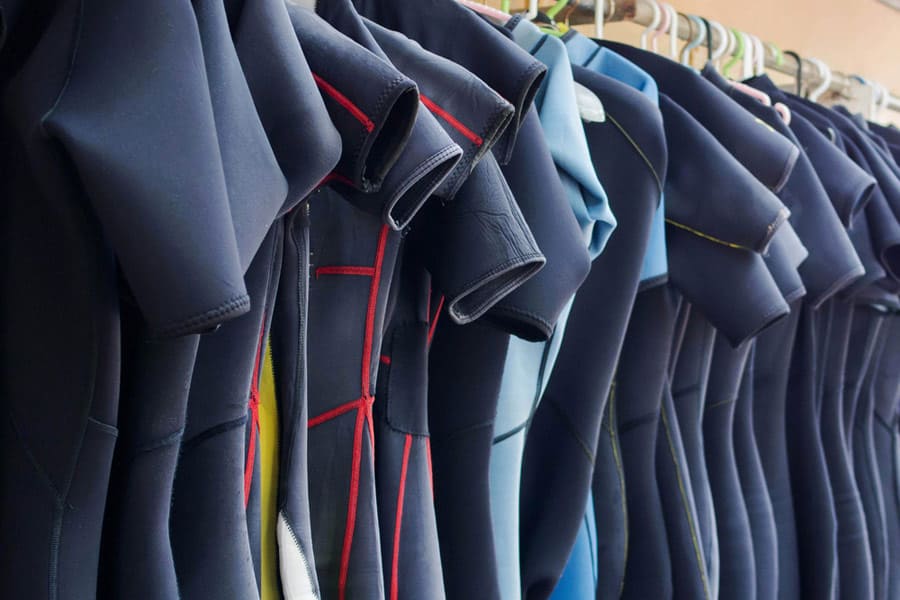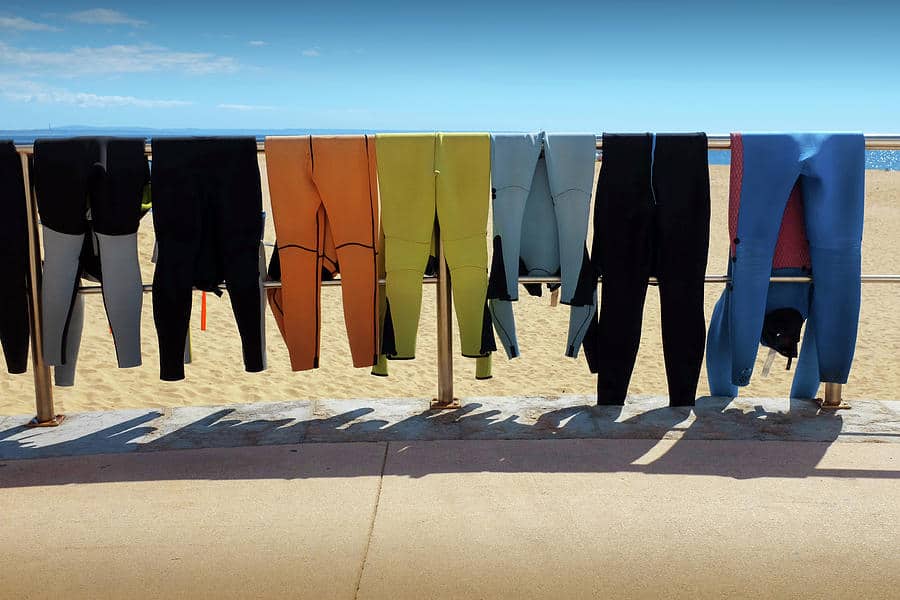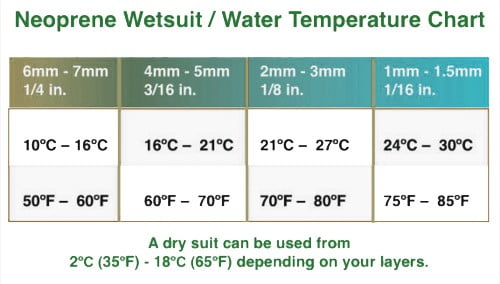Both wet suits and drysuits are utilized for thermal insulation from cold, winter air, and water temperatures, and in the inland surf sports world are popular for year-round waterway surfing, wintertime wake surfing and whitewater standup paddleboarding. Both are intended to keep you warm and the main contrast is in the material and functionality.
Wetsuits are made of elastic neoprene and are intended to keep you warm when wet, yet not at all like drysuits, they are not waterproof.
In this way, in the event that you have a baggy wetsuit you will get cold. Wetsuits that are skin-tight are ideal for cold water surf sports because they allow you to be more athletic than drysuits.
Drysuits, then again, are totally waterproof, however not intended for warmth whenever utilized alone. Drysuits keep all water out totally like a shell and fit freely like a major ski jacket.
Drysuits have been primarily utilized for kayakers and divers, however now utilized for standup paddling and in any event, wake surfing. New innovations like SUPSkins have created drysuits with wetsuit sport-fitting functionality.
When should you wear a drysuit vs wetsuit?
In most virus water conditions a wetsuit is progressively favorable for performance in the water, while drysuits are increasingly favorable out of the water. Why? Because of limitations. For in the water activities think wetsuit because they are meant to fit skin tight.
Consider swimming in a drysuit versus a wetsuit, which suit will allow for more speed and greater maneuverability?
For the individuals who would prefer not to get any virus water on their skin and don’t necessarily care about limitation, at that point a drysuit is a great alternative because of its waterproof characteristics.
In amazingly cool conditions when normal wetsuit developments become limited by the temperature, at that point drysuits would be increasingly favorable.
At the point when it’s virus think wetsuit for: surfing, wakesurfing, riversurfing (in the water activities).
At the point when it’s incredibly cool think drysuit for: kayaking, whitewater paddling, taking action photographs in the water (out of the water activities or in outrageous virus conditions).
For extraordinary winter standup paddleboarding conditions a drysuit is a great decision because you can add additional layers of warmth beneath the suit.
What is a wet suit?
A wetsuit gives thermal insurance to divers and takes a shot at the rule that your body is the best wellspring of heat. To help contain this heat underwater, these suits are made with a shut cell foam material, which is loaded up with thousands of small gas bubbles trapped inside the structure.
When you enter the water, the material allows a dainty layer of water through the suit, occupying the space between your body and the inward layer of material.
This layer of water warms up thanks to your internal heat level and helps keep you comfortably insulated all through your dive.
Scuba wetsuits are intended to fit near the body. A baggy wetsuit will let the water stream all through the gaps between the wetsuit and your skin, which means your body will wind up wasting vitality to heat the “new” water, making it silly for thermal insulation.
A wetsuit also has to be sufficiently thick to suit the temperature of the water you’re diving in. Wetsuits vary in thickness—the thicker ones give more insurance and insulation to colder waters, while the more slender ones offer lighter insulation in warmer waters.
However, recall that everybody’s body is unique, which is the reason a particular suit’s thermal performance will normally vary from individual to individual.
Some scuba divers can dive in tropical waters wearing just a lycra bodysuit, usually known as a dive skin, while others will require a 2mm-thick (or more) wetsuit. Some scuba divers can dive in cool water wearing just a 6mm-thick wetsuit, while others need the security of a drysuit.
Wetsuit Tips:
- The wetsuit seams are important to keeping the warmth inside the suit. Taped seams leak not exactly sewed ones and an elastic coated/welded seam is the best.
- Adaptability is key especially when purchasing a thicker suit (say more than 3/2mm). Try not to purchase excessively thick of a suit in the event that you needn’t bother with it, check your water temps and purchase the correct suit for the conditions.
- Various brands have various cuts. For example, one brand’s Medium Tall (MT) may be another’s Large (L). Always give suits a shot at whatever point conceivable to discover a suit that accommodates your size and body type.
- Uncovered sewing, cheap or dried-out neoprene, and ill-advised measured suits will give you wetsuit rash and will make you truly uncomfortable all through the water.
What is a dry suit?
A drysuit, as the name indicates, keeps you totally dry by guaranteeing that no water gets into the suit. It tends to be made out of foam neoprene, squashed neoprene, vulcanized elastic, or heavy-obligation nylon.
It’s also completely sealed and utilizes a combination of wrist seals, a neck seal, and a waterproof zipper to keep you dry.
Drysuits fit more freely than wetsuits and allow you to wear garments or other insulating layers underneath. They work by keeping an insulating layer of air between the body and the suit, which you can control with inflator valves that allow you to add gas as you go further.
Drysuits also make utilization of exhaust valves to release air during ascent. The inflator valve is similar in capacity to the force inflator on a buoyancy compensator vest and is frequently situated in the chest on the suit.
Maintaining neutral buoyancy in a drysuit requires certain aptitudes. Drysuit diving takes some becoming acclimated to and usually requires training and experience.
In case you’re keen on giving it a shot, we energetically suggest accepting legitimate training from a qualified educator.
Difference between wet suit and dry suit
A great part of the advertising one sees for diving includes warm water and divers in swimsuits or meager wetsuits. It very well may be somewhat of a stun to those divers who were guaranteed in warm water to make a pilgrimage to a virus water location.
For those of us who dive and teach in a great part of the northern side of the equator, talking about the distinctions is a lot of like talking about how to pick a mask.
We are frequently asked about the contrasts between diving wet and diving dry. Other than the conspicuous answer – “you don’t have to dry anything however your hair after the dive” – there are some key contrasts.
| Wet suit | Dry suit | |
Material | Foam Neoprene | Neoprene, Rubber, Nylon |
| Fit | Tight Fit | Loose Fit |
| Function | for Cold Waters | for Extremely Cold Waters |
1. Warmth
This is probably the most important reason to choose to dive dry. You realize that neither a wetsuit nor dry suit actually keeps you warm. What they do is moderate the amount of heat misfortune.
Wet suits do this utilizing a layer of neoprene and a flimsy layer of water trapped among that and the skin. Dry suits use air and a combination of undergarments. No water to take heat away if a seal is lost and allowed to flush through the suit. With drysuits you can add layers of insulation to slow the loss of body heat.
2. Buoyancy
Wetsuits pack with profundity and lose a portion of their inalienable buoyancy. Dry suits allow the diver to add air and compensate for the increased weight at profundity.
As the wetsuit packs, it gets more slender and loses insulating capacity. The dry suit does not.
3. Weighting
When a diver has gotten capable with a dry suit, over-weighting isn’t as a very remarkable worry as it is with a wetsuit.
As a wetsuit loses buoyancy at profundity, a diver can turn out to be intensely overweighted because of suit pressure.
With a dry suit, the amount of buoyancy the suit offers stays pretty much constant since the diver has the means to adjust for the increased/decreased weight.
4. Varying conditions
A large advantage of a dry suit is the ability to utilize the suit in various conditions. A wetsuit does not offer the adaptability of a dry suit to add or subtract undergarments to suit the water/surface conditions. Many divers utilize their dry suit year-round, from warm water locations to under the ice in winter.
5. Purchase cost
At one time dry suits were restrictively costly for the average diver. One could purchase several wetsuits for the expense of one dry suit. They frequently had to if diving in a wide range of water temperatures!
With the presentation of new materials and manufacturing rivalry, a quality section level dry suit can be had for generally the same cost as a better quality wetsuit.
By varying the undergarments the diver can also avoid having to purchase several distinct thicknesses of wetsuits. One dry suit will work in various conditions.
6. Cost of proprietorship
When a diver purchases a wetsuit there is next to no maintenance other than appropriate washing. Dry suits expect seals to be replaced, leaks attended to, boots or socks replaced, and maybe even the zipper.
These expenses may be balanced by the life of the suit. Dry suits, with appropriate care, can last 15 – 20 years or more. This is utilizing the suit on a regular basis-say 100 dives a year.
A wetsuit seeing that much use may last five years. Over the long haul, a drysuit may actually be more affordable. Dry suits frequently hold their value for resale. Utilized wetsuits get hurled. Utilized dry suits are offered to balance the expense of another one!
7. Maintenance
Taking care of a wetsuit is rather easy:
- After each dive, soak the wetsuit in warm freshwater for at least twenty minutes and then wash it off completely with clean new water.
- Leave the suit to air dry with its zippers open to allow for complete drying.
- To forestall the improvement of a permanent crease or damage to the zipper, store it lying flat or on a hanger in a cool and secured space with no immediate daylight.
A drysuit requires more care as you have to maintain the seals and zippers, which are the most delicate part of the suit:
- After a dive, flush the suit with clean new water both all around.
- Give the seals and zipper(s) a great wash to evacuate the potential contaminants that may damage them.
- As with a wetsuit, leave the drysuit out to air dry, preferably topsy turvy.
- Lubricate the zipper(s) with beeswax or a similar item and softly coat the seals with talc to forestall dying.
- Store the drysuit on a hanger in an ensured space with no immediate daylight.
- Replace the seals, valves, or zipper(s) or do minor repairs when you see indications of wear.
FAQ
1. Do the various sorts of neoprene, linings, and seams impact the quality of the wetsuit?
As a general guideline: the lighter the suit, the more stretch it will have. Additionally, if the material has stretch to it, it will keep you warm.
By the by, as a potential drawback, higher grade neoprene is on the costly side. Also, wetsuits with flatlock sewed seams are cheaper in comparison with stuck seams; however the later allow less water to experience, which is the reason a great many people lean toward them.
2. How long does a drysuit last?
Durability is a primary worry for most clients – and this makes sense, taking into account that a top-notch diving wetsuit is a significant speculation. Obviously, you should assess how frequently you’ll be utilizing the wetsuit.
Typically, a wetsuit can be utilized for around two seasons or something like that. This doesn’t necessarily mean that you won’t have the option to utilize it afterward. It just means that it is probably going to lose its effectiveness, as in it won’t keep you as warm as it did at the outset.
3. Are wetsuits expected to be really tight?
We’ve already talked about the importance of picking a wetsuit that has a conventional fit. By the by, this doesn’t mean that you ought to get a thing that is excessively close, as this could affect your solace. That is to say, wetsuits are planned so as to be formfitting.
There shouldn’t be any free overlap of neoprene or, far and away more terrible, pockets of air or water. And despite the fact that the wetsuit may appear to be somewhat close when you originally put it on when you get in the water, it will release considerably.
4. What would it be advisable for you to wear under a wetsuit?
Taking into account that your wetsuit is slim, you should wear thermal lycra or neoprene shorts underneath the wetsuit. Along these lines, you’ll get an increase in insulation and you won’t feel cold.
Beginners guide to choosing a Dry suit vs Wet suit more information in video bellow
Conclusion
With regards to picking the correct scuba suit, there is no compelling reason to feel overpowered. Simply consider the sort of diving you plan on doing, where you plan on diving, and the seasons wherein you want to dive.
On the off chance that you believe that you will dive in freezing or even bone-chilling waters a ton, at that point it is a smart thought to put resources into a quality dry suit.
On the off chance that you are just going to dive throughout the late spring a long time in warmer waters, a wet suit will do the trick.
In the event that you can afford it, why not simply get one of each? That way, you will have a suit for any kind of dive you wish to do.








